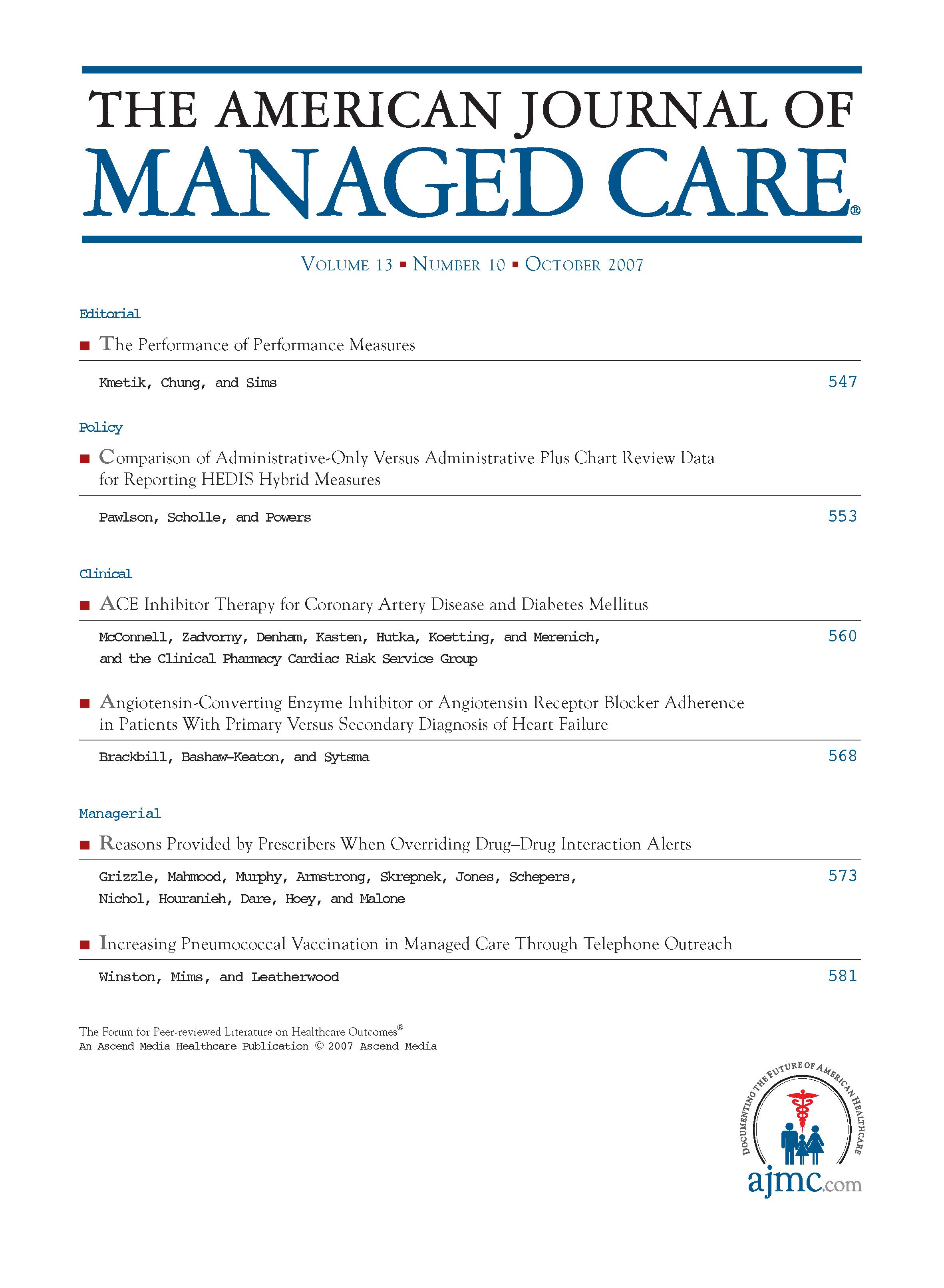- Center on Health Equity & Access
- Clinical
- Health Care Cost
- Health Care Delivery
- Insurance
- Policy
- Technology
- Value-Based Care
Angiotensin-converting Enzyme Inhibitor or Angiotensin Receptor Blocker Adherence in Patients With Primary Versus Secondary Diagnosis of Heart Failure
Context: It is unknown whether hospitalization for a secondary diagnosis of heart failure (HF) impacts adherence to current HF guidelines. National HF databases that benchmark quality of care currently do not report on adherence based on whether HF is the primary or secondary diagnosis.
Objective: To describe angiotensin-converting enzyme inhibitor (ACEI) or angiotensin receptor blocker (ARB) utilization at time of discharge in hospitalized patients with a primary or secondary diagnosis of systolic HF.
Study Design: Six-month observational chart review.
Methods: Patients were included if they were hospitalized with a primary or secondary diagnosis of HF, had an ejection fraction of =40%, and were more than 18 years of age. Guideline adherence was defined as appropriate if an ACEI or ARB was prescribed at discharge or if there was a documented contraindication.
Results: Of 204 patients in the study, 170 and 34 patients had a primary or secondary diagnosis of HF, respectively. Eighty-six percent of patients with a primary diagnosis of HF were discharged with an ACEI or ARB, whereas 71% of patients with a secondary diagnosis of HF were discharged with an ACEI or ARB (P = .029).
Conclusion: Patients with a primary diagnosis of HF are more likely to be discharged on an ACEI or ARB (if indicated) than those with a secondary diagnosis. Identifying and evaluating the need for an ACEI or ARB in hospitalized patients with a secondary diagnosis of HF offers practitioners an opportunity for improved patient care through better adherence to national guidelines.
(Am J Manag Care. 2007;13:568-570)
are presented in Table 1.
DISCUSSION
Use of the term “secondary diagnosis†for HF may imply that less importance is attached to this illness than is attached when HF is a primary diagnosis. In the study population, the prioritization of the diagnosis is the only difference. Baseline demographics, documented EFs, and number of previous hospitalizations for HF were similar for the 2 groups, indicating that each study arm would potentially benefit from ACEI or ARB therapy.
Secondary or comorbid conditions are frequently the reasons for complicating care and extending hospital stays. In the administrative world, these complications translate quickly into increased costs and problematic bed utilization. Maximizing treatment for comorbidities is crucial for optimizing patient outcomes. National guidelines have been established to direct evidence-based care for all HF patients regardless of setting: hospital, physician office, or home. Healthcare providers have an obligation to meet or exceed these guidelines.
In the hospital setting, there is a unique opportunity to implement guideline-driven practice. In addition to the immediate effects on quality of care, readmissions may be decreased. Heart failure readmissions are costly both emotionally and financially to patients, families, and the providers of healthcare. When the opportunity to start an ACEI or ARB is missed in the inpatient setting, patients who may have the most to gain are being deprived of therapies proven to decrease morbidity and mortality.
There are several limitations to this study. The study was small and only represented HF patients at a single hospital over a 6-month period. The research was observational innature, and the accuracy of the information was dependent on the completeness of the medical record. Information on comorbid conditions was not collected. Healthcare providers may not have initiated therapy with an ACEI or ARB in the inpatient setting for reasons related to clinical status (eg, hypotension) that were not documented in the medical record. No follow-up data were collected, which limits the ability to identify patients who may have been started on an ACEI or ARB in the outpatient setting. Further research may include a larger trial with other therapies important for the treatment of HF such as beta-blockers.
CONCLUSION
Hospitalized patients with a secondary diagnosis of HF are less likely to be discharged with an ACEI or ARB than are those with HF as a primary diagnosis. Patients with a secondary diagnosis of HF, even if a minority, are still included in some databases that benchmark adherence to nationally recognized guidelines. Closer attention to patients with a secondary diagnosis of HF may increase adherence to HF guidelines. More important, such adherence will improve quality of care and perhaps quality of life for all HF patients.
2. Fonarow GC, Abraham WT, Albert NM, et al. Association between performance measures and clinical outcomes for patients hospitalized with heart failure. JAMA. 2007;297:61-70.
4. Fonarow GC,Yancy CW, Heywood JT, et al. Adherence to heart failure quality-of-care indicators in US hospitals. Arch Intern Med. 2005;165:1469-1477.

Trends in Hospital Pricing for Vulnerable Emergency Department Users, 2021-2023
December 4th 2025Self-pay emergency department prices rose significantly from 2021 to 2023, especially at for-profit and system-affiliated hospitals, highlighting growing affordability challenges for uninsured and underinsured patients.
Read More
Integrated Care for Chronic Conditions: A Randomized Care Management Trial
December 3rd 2025The authors sought to understand the differential impact of payer-led community-based care management approaches on stakeholder-oriented outcomes for publicly insured adults with multiple chronic conditions.
Read More

